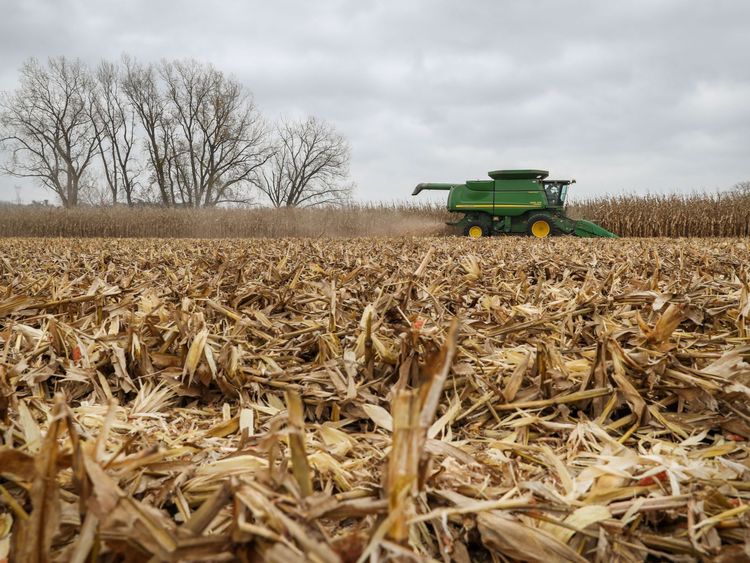Average prices for high-quality farmland increased over the past year in seven leading agricultural states, held steady in seven others and declined in Nebraska and three others, an Omaha farm management company said.
Counting all crop and ranch land in the 18 states, including less-productive land, prices are down slightly but more stable than over the previous several years, said Randy Dickhut, senior vice president of real estate operations for Farmers National Co.
“We think this is just kind of a stabilizing time,” Dickhut said Thursday. All things considered, he said, “I’d still say there’s a trend that it will soften more. We don’t think we’re done going down.”
Farmers National compiled sale price information from land grant colleges, Farm Credit banks and other industry sources.
The report said prices for irrigated cropland in Nebraska averaged $9,000 an acre in 2017, down from $9,500 in 2016 and $10,000 in 2015. The average for high-quality Iowa farmland was $10,500 last year, up from $10,100 in 2016 and 2015.
Sam Kain, a sales manager for Farmers National in West Des Moines, said prices for good farmland increased slightly after the 2017 harvest.
Dickhut said prices in eastern Nebraska have shown some increases because of good demand, while buying in the western part of the state has been “less aggressive.”
Lower-quality cropland and grassland “struggles to find buyers” because of low commodity prices, said Paul Schadegg, a sales manager in Sidney, Nebraska. Most sellers are families and estates.
Nationally, land prices generally have declined in recent years, but that’s from all-time highs in 2013, according to Iowa State University.
Speculation by nonfarm investors, some of whom were looking for better returns because of today’s low interest rates, and high prices for farm commodities helped push prices to record levels in the decade before 2013.
Since then, average prices have dropped steadily, often by 10 percent or more annually, largely because of lower prices for grain and other farm goods.
For the high-quality land, Farmers National said, average prices from 2016 to 2017 rose in Illinois, Indiana, Iowa, Missouri, North Dakota, South Dakota and Washington. Prices were unchanged in Arkansas, Kentucky, Minnesota, Mississippi, Oklahoma, Tennessee and Texas.
Prices dropped in Kansas, Michigan, Nebraska and Ohio.
From 2015 to 2016, average prices dropped in 10 states, were unchanged in six and increased in two.
One reason for the stability is that there has been less farm- and ranchland for sale in the past year, Dickhut said, while demand has been “steady to slightly stronger.”
Is 2017’s relative stability a sign of a longer turnaround?
Dickhut said that’s possible but not certain. A number of factors could influence prices up or down this year and beyond.
On the positive side, crop yields have been good, adding to farm income in most grain-producing areas, he said. That keeps farmers optimistic and willing to pay more at land auctions, partly because they have money available to expand their land holdings.
Interest rates remain low, so there are still investors looking for better returns by diversifying into farm real estate, he said.
Negative factors include low grain prices, expenses for fertilizer and equipment and payments on past land purchases, leaving less cash to buy land, he said. Lenders also are cautious about how much money they will lend for buying land.
Congress passed a new tax law and is due to consider a new farm bill this year, he said, both of which may have “unexpected consequences” that could be negative for agriculture. Changes in U.S. trade policy also could influence land prices.
If farmers have cash problems or worries about their investments, Dickhut said, they could put up more land for sale, which could hold down prices.
High-quality land values by state
Average sale prices per acre
Source: Farmers National Company Agent Survey
| Month | Iowa | Illinois | Kansas | Missouri | Nebraska | N. Dakota | Oklahoma | S. Dakota |
|---|---|---|---|---|---|---|---|---|
| Jan. 2016 | $10,100 | 11,200 | 4,000 | 6,100 | 10,000 | 6,000 | 3,000 | 8,000 |
| Jan. 2017 | 10,100 | 11,000 | 4,500 | 6,100 | 9,500 | 5,500 | 2,500 | 7,400 |
| Jan. 2018 | 10,500 | 11,200 | 4,000 | 6,200 | 9,000 | 6,000 | 2,500 | 8,000 |
































